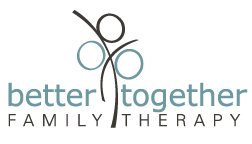Tips for Managing ADHD, Anxiety, and Autism
Try these neurodivergence friendly ideas from our expert Child and Family Therapists
Subscribe to our newsletter for more like these.
We Specialize in Autism Treatment*. Here’s Why We Think Autism Isn’t the Problem.
*First, a caveat about “treating autism.” We say it like that because people Google it in those words. And we want those people to find us. And hear why the autism isn’t the problem we treat.
Autism, like ADHD, is a form of neurodivergence. It is a way in which a brain functions. It’s easier to live a great life with an autistic brain when you understand your autistic brain. And when your family does too.
That’s how we help. We’re a translator of sorts between neurodivergent (ADHD, autistic, etc.) brains, and neurotypical ones. We help neurodiverse families build joyful lives that work for them. And no two are the same.
Parent therapy is an evidence based treatment for child ADHD and anxiety
Data shows, again and again, that working with parents is the most efficient way for therapists to help kids with ADHD. And with anxiety. (See SPACE Treatment.)
That’s great news! It means that you might not have to spend your evening or your Saturday bringing your child to our Kensington office. (Don’t get us wrong…our office is AWESOME. But an extra commitment in your child’s schedule isn’t always helpful.) Learn more about our approach to parent-first child therapy here.
Treatment for ADHD in women
Therapy doesn’t only help your child. Moms of kids with ADHD may have undiagnosed ADHD themselves. Women are especially likely to go through life undiagnosed. This means missing out on the benefits of understanding your beautiful brain. Jessica Check LGPC explains why we miss the signs and what to do about it in this post.
How an ADHD diagnosis can help adults
If you’ve wondered if you might have ADHD, there are real reasons to find out. You can treat your ADHD symptoms by simply learning that you have ADHD, and understanding how ADHD works. An experienced ADHD therapist is definitely a big help. But even if you don’t want to try therapy, the diagnosis itself can make life easier.
Let’s start with an understanding of what ADHD is. ADHD = Attention Deficit Hyperactivity Disorder. We call it that even if you aren’t hyperactive. (There’s inattentive type, hyperactive-impulsive type, and combined type).
Most adults aren’t hyperactive in the way children might be. We don’t jump off of furniture or climb the walls. Here’s why you still might have the hyperactive-impulsive type of ADHD.
As we grow, we learn to keep our brains activated using smaller movements (tapping our feet or twirling our pens). Or we become extra talkative or impulsive in what we say.
Is ADHD a mental health condition?
Yes. Could it also be considered a strength? Absolutely. Our ADHD therapists recommend reading ADHD 2.0 to start learning about how ADHD works for (and against) you.
How to Feel Less Anxious (with or without Art Therapy)
There really are ways to feel less anxious. It’s about getting your body on board so the calm comes from within. Start with some deep breathing. Close your eyes or use headphones to eliminate unnecessary stimuli.
If you start to feel disoriented, bring yourself back using grounding techniques. Add a visualization exercise, like building a happy place in your mind that you can visit (mental beach, anyone?). Use these tools in a moment of stress, or every day to build resilience.
Connecting with yourself can also be a vital tool for managing anxiety day to day. Art Therapist Shantel Elessie recommends setting aside some time to connect deeply with yourself through art. Her most recent post walks you through a 3 stage art project designed to get you in touch with your best self.
Try Art Therapy for Anxiety
We’re very lucky to have a Licensed Art Therapist on our team. She recently took some time to explain exactly how Art Therapy can alleviate anxiety symptoms. And strengthen executive function in those with ADHD.
Every month we send a newsletter to hundreds of families on our email list. We don’t want our readers on the blog or social media to miss out! Click here to add your email to the list. (We will NEVER sell or share our list.) Or follow us on Facebook or Twitter to see our content when it is posted.


